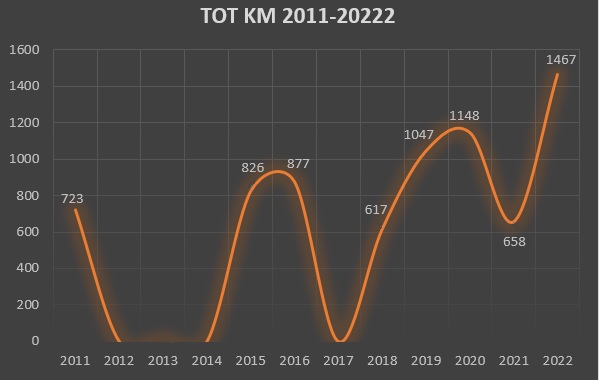I have to admit it: I am sick and tired of spending hundreds of bucks (even if I've never spent more than 80 € for a pair of "technical" shoes) for the "big brands". We all know very well that a large part of that money covers marketing, shipping, insurance, distribution, design costs. At the end of the day, the "real" cost of a pair of Nike or Adidas shoes is around 15 €. Furthermore, I am not keen at encouraging the production strategy of these companies, which force their employees to work under stressful conditions over long and low-paid shifts. I'm not a marketing expert, but I would much prefer to give my money to a company based in my region (or at least in Europe), which ensures human working conditions for its employees and reduces shipping costs (and thus: prices) by distributing its products regionally. Ok, I guess that the head of this company would never become a millionaire...
Back to the topic of this post, today I've received a pair of Adidas Supernova M shoes, which I ordered from "Sportamore" website (don't let the name deceive you: the seat is not in Neaples, it's in Sweden!). In spite of the distance, the shoes have been delivered in less than 3 days. I had tried a similar version (Supernova Unite) at the Decathlon local shop, to be sure that they were true to size (I ordered a US 9,5 size, which corresponds to 43 1/3, at least according to Adidas size chart). The site offered a white model at a cost of 30 € plus 5 € shipping costs, whereas Decathlon currently sells an "upgraded" model (meaning: with a wider "boost" element on the midsole) at 65 € with a 50% [fake] Black Friday discount (the full prize should be 130 € - crazy!).
This afternoon I tested them with a 12 km easy run (4'50" / km) and here are my first impressions:
- compared to the Peg34, they feel a little bit "stiffer", most of all in the forefoot. This is probably due to the shape of the sole, which is larger and flat, whereas the Nike one is shaped according to the foot. Anyway, this Adidas doesn't have the 2 Zoom units, and I could clearly perceive that; instead, the ammortisation & reactivity should be ensured by a combination of a Boost element under the heel and the Bounce segment on the forefoot. My impression: I run twenty 500m-rings, the first 250 meters with forefoot running and the last 250 meter leaning the whole foot on the ground, and I can say that the Boost is satisfactory and the Bounce is decent. Test passed successfully!
- In spite of these differences, the shoe is comfortable, thanks to the padding around the ankle and a soft insole (made with recycled material). The minimalistic tongue and mesh (similar to the Streak 6, but not that light) don't reduce comfort and stability. Adidas official website says they weight 320 g, but they feel somehow lighter than the Peg34 (295 g), which are for sure bulkier inside (due to more padding).
- Due to the uneven sole consumption (I am a pronator), during the last runs I had with the Peg34 I started suffering from backache while running. With these brand new Adidas my running experience was a real pleasure. On the other hand, I already can perceive signs of deterioration on the rubber sole. Hopefully it won't wear out so quickly (on a post written by a customer, I read that their life expectancy is around 700 km).
- I confirm the reviews I read and heard on the pace you can hold with these shoes: pretty stable and reactive when I kept a 4'45" - 5'00" pace, less performing when I pushed them beyond the 4'30" limit. But I still have 3 Nike Streak pairs for that :)
All in all, I can say I am satisfied, most of all considering the price-quality ratio: I would have never spent 100 and more bucks for the new model of the Nike Pegasus this round. Of course, my evaluation of the Supernova M will be updated regularly. Only time will tell...
*** UPDATES: 100 KM TEST ***
This is my verdict after 100 km covered with the Adidas Supernova M:
The "Adis" are quite comfortable and "soft"; however, as perceived by other runners who shared their comments online, I can feel a certain "stiffness" on the instep, more precisely on the spot where the tongue is fixed to the upper. This sensation tends to fade away after a few steps, though.
Another drawback is caused by the collar: even if it's quite padded, for reasons which still I have to understand, it scratched my left ankle (probably because I run clockwise when I do my interval training and running sessions around a square - this means that my left foot bend leftwards at every curve, and this could explain the contact between ankle and collar).
Yesterday, due to a rainy day which could have spoiled my brand-new white Supernova, I decided to brush up my old Pegasus and this gave me the chance to compare the two models. Surprisingly, I felt the Peg much more reactive, more comfortable and lighter than the Supernova. And I could feel again the difference when it comes to the Zoom units. However, I confirm the opinion I had when I first wear those shoes: the Peg are less ideal for speedy sessions, but they are more protective during long sessions or when the wheather is nasty.
Conclusions: in terms of quality, shape and comfort The Nike Pegasus 34 are superior than the Adidas Supernova, which I consider still a good pair of shoes for distances from 5K to 15K at a medium pace under good wheather conditions.






